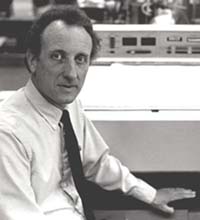

Professor of Chemistry Norman Craig will attempt to break the second law of thermodynamics this year; by retiring, he hopes to battle entropy head on..
Upon entering Craig's office, it immediately becomes evident how many academic lives Craig has influenced in his time here at Oberlin. His walls are decorated with student artwork and creative gifts from students.
Unfortunately, Craig will not be adding to his collection past this academic year. He is retiring after 43 years of teaching chemistry at Oberlin.

In addition to the student contributions, Craig's walls are decorated with teaching honors and awards. These include the Catalyst Award in chemical education from the Chemical Manufacturers Association in 1987 and the American Chemical Society Award for Research at an Undergraduate Institution in 1996. Craig is obviously proud of each of his students and is eager to share his enthusiasm about chemistry and learning in general.
Professor of Chemistry Martin Ackermann said, "Anytime you go by Kettering his light is on."
Of his classes, Craig said, "I really enjoyed them all. Whichever ones I'm doing at the time I find myself fully involved in."
He added, "There is always something new. It's really quite absorbing."
Craig said he is most interested in thermodynamics. He has put a lot of effort into teaching this subject to honors students as well as first-years. A prominent authority in his field, Craig authored Entropy Analysis which is used in the thermodynamics and intro courses here at Oberlin.
Craig said, "It offers a new way of teaching that subject." He has also enjoyed teaching Environmental Chemistry, a course he designed in the 1980s.
Craig is interested in incorporating lecture demonstrations in all of his courses. He explained that lecture demonstrations are a fairly unique concept in the field of physical chemistry because most people think that it is a very mathematical and theoretical subject. He noted, however, that his demonstrations work well as a teaching tool and that they are interesting both for him and for his students.
Craig highlighted one of his recent lecture demonstrations in which he tried to recreate Charles Martin Hall's experiment by which he discovered the process for refining aluminum.
"I got involved with the history surrounding Hall almost by accident," said Craig.
That was in the mid-1980s when he did Hall's experiment in a public lecture demonstration for the centennial anniversary of Hall's great discovery.
Since that time, Craig has been involved with research about Hall and the historical aspects of the chemistry department.
Craig has written the history of many leading chemistry professors at Oberlin. He has carefully documented the Steiner era, the Holmes era, the Jewett era and many more.
"The next chapter in the history [of chemistry at Oberlin] is very clearly the Craig era," said Ackermann.
Craig's interest in the history of science at Oberlin has given him an appreciation for the department's advances. "When Kettering opened in 1961, it was a tremendous boost to the teaching and doing of science at Oberlin and the facilities in new science center promise a similar leap forward in science and also in the linkage of science to other areas of the College," he said.
Craig's personal history at Oberlin reaches back quite a few years. An Oberlin graduate himself of the class of 1953, Craig feels a strong connection to the place where he has spent most of his life. Craig returned to Oberlin as a faculty member in 1957 after getting his PhD at Harvard.
"I had never imagined that I would return to Oberlin," said Craig.
He initially had some reservations about working with the professors he studied under, but, he said, "I've never regretted it."
Craig also met his wife, Ann, at Oberlin and two of their three children attended the College.
Craig spends every summer, as well as a portion of the school year, working with students on projects, the majority of which are published. Most of his research is aimed at understanding the dynamics of small molecules and ions, specifically substances containing fluorine. "It leads to very interesting and surprising things."
In addition to his work in the chemistry department, Craig has worked with students in many outside ways. He has been a member of many faculty committees, including admissions.
"I have done just about everything a faculty member can do in admissions," he said.
When he was chair of the Shansi Foundation, which supports Oberlin graduates who wish to teach overseas, he helped raise over $1 million for the foundation's endowment.
"I've done a variety of things here and I find them all interesting," Craig said.
"It's really time to retire," he said, "It's been a pretty long run. Finally, one does have to make room for others."
He said that he and his wife intend to stay in Oberlin and that he plans to stay involved with the community. Craig said, "I've had a good life here and I expect to continue to have one." Craig will continue his research work with students, though he will perhaps take off summers to do some traveling.
Back in the day: Norman Craig, who has spent 43 years at Oberlin, will retire this year. Fluorine(!) will never be the same. (file photo)
Copyright © 1999, The Oberlin Review.
Volume 128, Number 6, October 8, 1999
Contact us with your comments and suggestions.